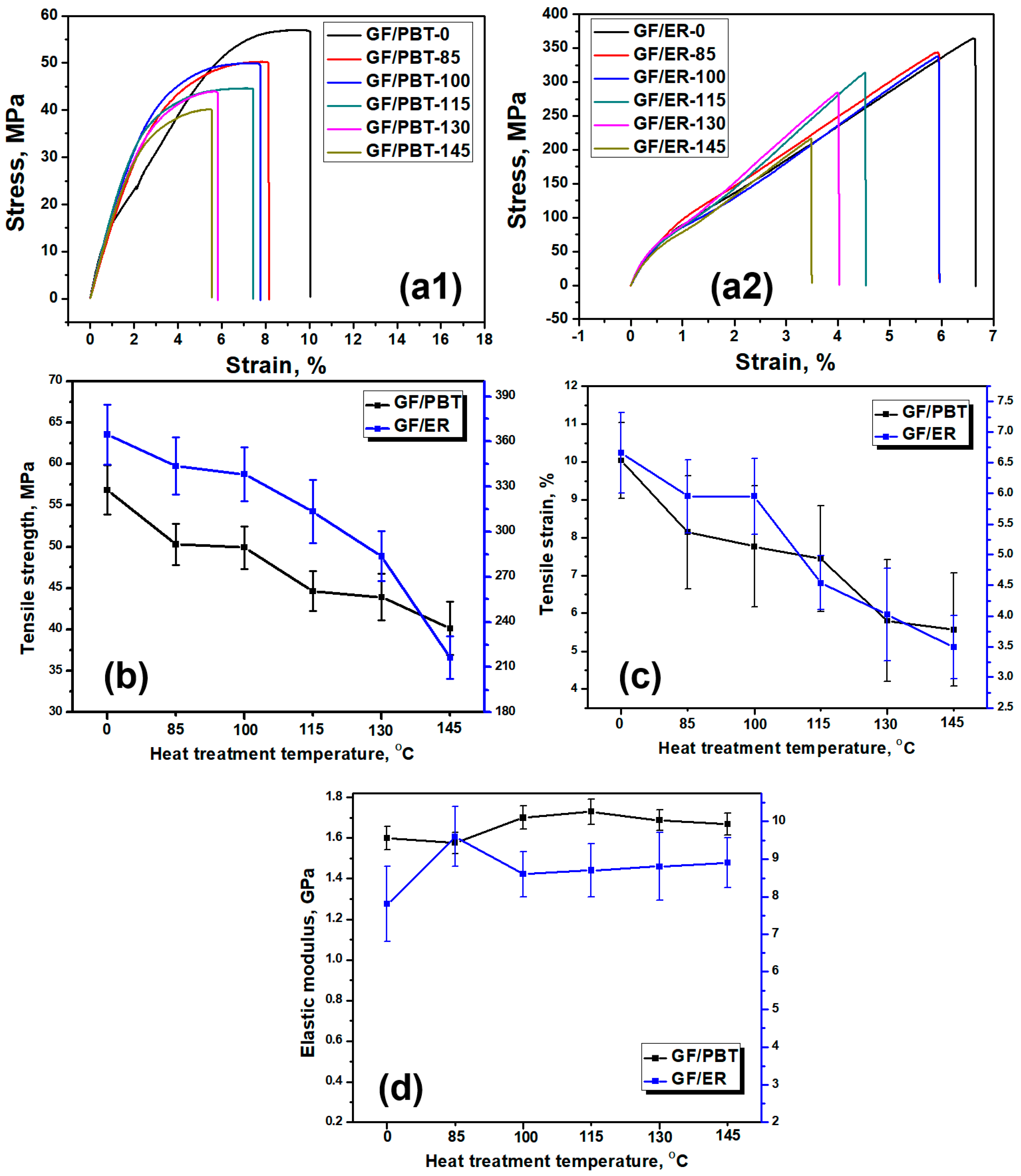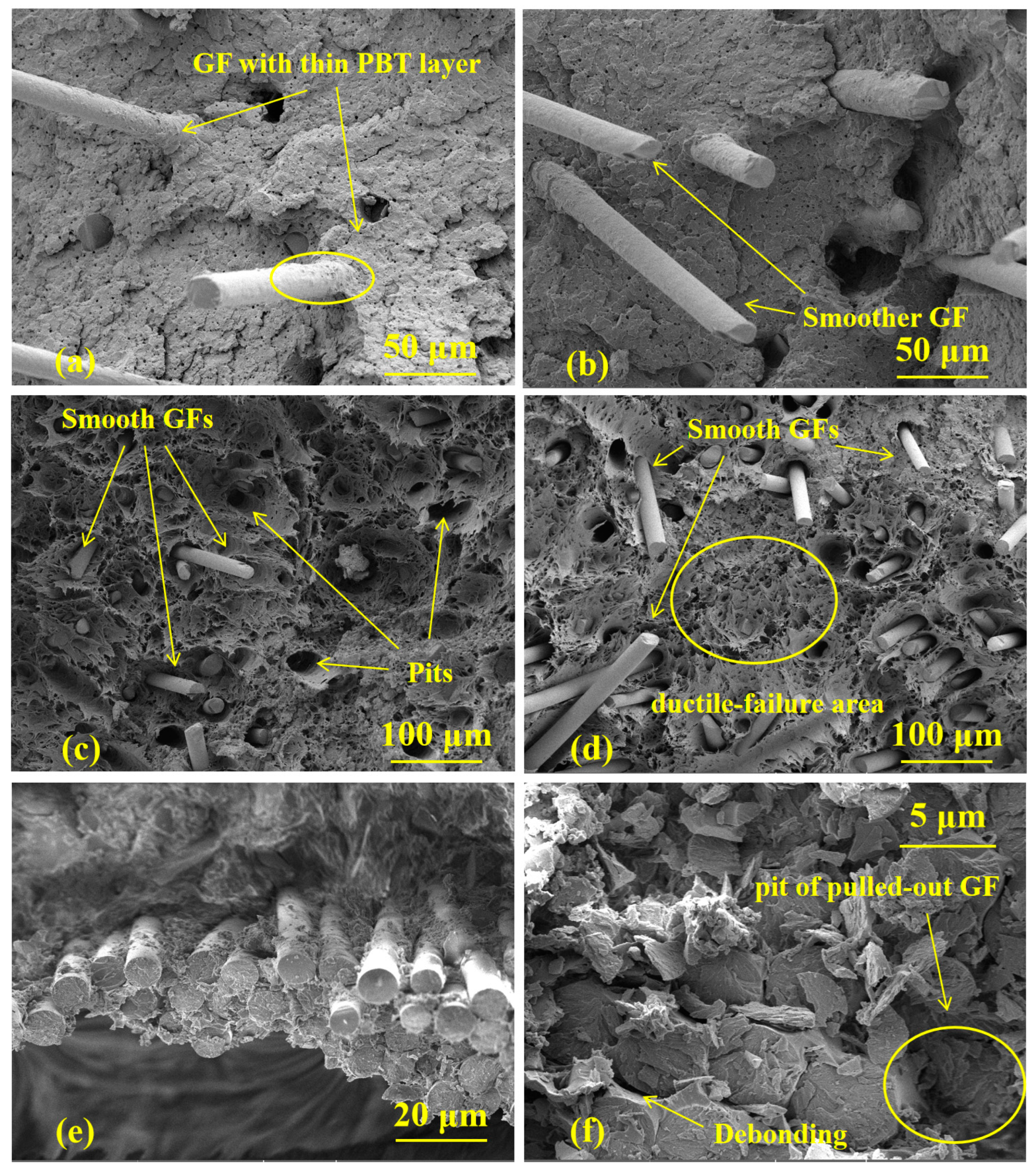Thermal Treatment Effects on Structure and Mechanical Properties of Polybutylene Terephthalate and Epoxy Resin Composites Reinforced with Glass Fiber
Abstract
1. Introduction
2. Materials and Methodology
2.1. Materials and Sample Preparation
2.2. Characterization Techniques
3. Results and Discussion
3.1. Tensile Properties
3.2. Microscopic Analysis of Fracture Morphology
4. Conclusions
Author Contributions
Funding
Institutional Review Board Statement
Informed Consent Statement
Data Availability Statement
Conflicts of Interest
References
- Johnson, T. The Many Uses of PBT Plastics. Thougtco. 11 August 2019. Available online: https://www.thoughtco.com/what-are-pbt-plastics-820360 (accessed on 31 March 2020).
- Radusch, H.J. Poly (Butylene Terephthalate). In Handbook of Thermoplastic Polyesters, 1st ed.; Fakirov, S., Ed.; Wiley: Hoboken, NJ, USA, 2002; pp. 389–419. [Google Scholar]
- Pyda, M.; Nowak-Pyda, E.; Heeg, J.; Huth, H.; Minakov, A.A.; Di Lorenzo, M.L.; Schick, C.; Wunderlich, B. Melting and crystallization of poly(butylene terephthalate) by temperature-modulated and superfast calorimetry. J. Polym. Sci. B Polym. Phys. 2006, 44, 1364–1377. [Google Scholar] [CrossRef]
- Cheng, S.Z.D.; Pan, R.; Wunderlich, B. Thermal analysis of poly (butylene terephthalate) for heat capacity, rigid-amorphous content, and transition behavior. Makromol. Chem. 1988, 189, 2443–2458. [Google Scholar] [CrossRef]
- Complete Guide on Polybutylene Terephthalate (PBT). Omnexus. 2020. Available online: https://omnexus.specialchem.com/selection-guide/polybutylene-terephthalate-pbt-plastic (accessed on 31 March 2020).
- Xin, D.R. Study on Mechanical Properties and Interface Failure Mechanism of Epoxy Resin in Wet-Thermal Environment; South China University of Technology: Guangzhou, China, 2013; pp. 54–56. [Google Scholar]
- Troeger, C.; Bens, A.; Bermes, G.; Klemmer, R.; Lenz, J.; Irsen, S. Ageing of acrylate based resins for stereolithography: Thermal and humidity ageing behaviour studies. Rapid. Prototyp. J. 2008, 14, 305–317. [Google Scholar] [CrossRef]
- Loyer, C.; Régnier, G.; Duval, V.; Ould, Y.; Richaud, E. PBT plasticity loss induced by oxidative and hydrolysis ageing. Polym. Degrad. Stab. 2020, 181, 109368. [Google Scholar] [CrossRef]
- Zhang, D.H.; He, M.; He, W.D.; Zhou, Y.; Qin, S.H.; Yu, J. Influence of Thermo-Oxidative Ageing on the Thermal and Dynamical Mechanical Properties of Long Glass Fibre-Reinforced Poly (Butylene Terephthalate) Composites Filled with DOPO. Materials 2017, 10, 500. [Google Scholar] [CrossRef]
- Chen, C.; Wang, Y.; Chen, J.; Deng, L.; Mao, C.; Zhou, X. Study on thermal aging properties of PBT energetic elastomer. Propellants Explos. Pyrotech. 2023, 48, e202200233. [Google Scholar] [CrossRef]
- Souilem, S.; Doulache, N.; Khemici, M.W.; Gourari, A. TSDC study of electrical aging of polybutylene terephthalate (PBT). IEEE Trans. Dielectr. Electr. Insul. 2018, 25, 791–796. [Google Scholar] [CrossRef]
- Souilem, S.; Doulache, N.; Khemici, M.W.; Khemici, M.W.; Gourari, A. TSDC and DSC Study of Effects of Physical Aging on Polybutylene Terephthalate (PBT). Int. J. Polym. Anal. Charact. 2014, 19, 175–188. [Google Scholar] [CrossRef]
- Yang, J.L.; Jiang, B.; Zhen, Y. Long-term moisture effects on the interfacial shear strength between surface treated carbon fiber and epoxy matrix. Compos. Part A Appl. Sci. Manuf. 2015, 78A, 311–317. [Google Scholar]
- McGrath, L.M.; Parnas, R.S.; King, S.H.; Schroeder, J.L.; Fischer, D.A.; Lenhart, J.L. Investigation of the thermal, mechanical, and fracture properties of alumina epoxy composites. Polymer 2008, 49, 999–1014. [Google Scholar] [CrossRef]
- Odegard, G.M.; Bandyopadhyay, A. Physical Aging of Epoxy Polymers and Their Composites. J. Polym. Sci. Part B Polym Phys 2011, 49, 1695–1716. [Google Scholar] [CrossRef]
- Rivaton, A. Photochemical and thermal oxidation of poly (2, 6-dimethyl-1, 4-phenylene oxide). Polym. Degrad. Stab. 1995, 49, 11–20. [Google Scholar] [CrossRef]
- Lin, X.B. Mechanism analysis of thermal oxygen aging of epoxy resin binder. Chem. Enterp. Manag. 2017, 8, 106–108. [Google Scholar]
- Tang, B.; Xv, Y.; Wang, J.; Wang, Z. Pyrolysis Characteristics of Cured Epoxy Resin with Different Curing Systems. Liaoning Chem. Ind. 2022, 51, 1674–1681. [Google Scholar]
- Hashima, K.; Usui, K.; Fu, L.X.; Inoue, T.; Fujimoto, K.; Segawa, K.; Abe, T.; Kimura, H. Super Ductile PBT Alloy With Excellent Heat Resistance. Polym. Eng. Sci. 2008, 48, 1029–1230. [Google Scholar] [CrossRef]
- Sanchez, E.M.S. Ageing of PC/PBT Blend: Mechanical Properties; SAE Technical Paper Series, 2005-01-4044; SAE International: Warrendale, PA, USA, 2005. [Google Scholar]
- Borukaev, T.A.; Kozlov, G.V.; Mashukov, N.I.; Mikitaev, A.K. Mechanisms of thermo-oxidative degradation of modified polybutylene terephthalate. Plast. Massy 2002, 9, 26–29. [Google Scholar] [CrossRef]
- Bardash, L.V.; Fainleib, A.M.; Grigoryeva, O.P.; Boiteux, G. Nanocomposites based on polybutylene terephthalate synthesized from cyclic oligomers of butylene terephthalate and multiwalled carbon nanotubes. J. Nano Electron. Phys. 2015, 7, 01018. [Google Scholar]
- Wen, B.; Zheng, X. Effect of the selective distribution of graphite nanoplatelets on the electrical and thermal conductivities of a polybutylene terephthalate/polycarbonate blend. Compos. Sci. Technol. 2019, 174, 68–75. [Google Scholar] [CrossRef]
- Hoeks, T.; Goossens, J.; Vermeulen, H.; Shaikh, A.A.G. Improved chemical resistance of transparent bisphenol A polycarbonate materials. Polym. Eng. Sci. 2022, 62, 1377–1385. [Google Scholar] [CrossRef]
- Novais, R.M.; Carvalheiras, J.; Capela, M.N.; Seabra, M.P.; Pullar, R.C.; Labrincha, J.A. Incorporation of glass fibre fabrics waste into geopolymer matrices: An eco-friendly solution for off cuts coming from wind turbine blade production. Constr. Build Mater 2018, 187, 876–883. [Google Scholar] [CrossRef]
- Yang, Y.; Xian, G.; Li, H.; Sui, L. Thermal aging of an anhydride cured epoxy resin. Polym. Degrad. Stab. 2015, 118, 111–119. [Google Scholar] [CrossRef]
- Zheng, T. Preparation and properties of carbon fiber modified epoxy resin matrix composites. Funct. Mater. 2022, 53, 12147–12151. [Google Scholar]
- Hu, H.; Wang, J.; Feng, X.; Qin, H.; Deng, Y.; Liu, W. Thermal Stability of Polyaryl Ether Ketone Modified Epoxy Composite. Plastics 2022, 51, 30–34. [Google Scholar]
- Li, H.; Ding, Y.; Zhang, Y.; Xiang, J.; Wang, J.; Li, J. Preparation and mechanical properties of glass fiber reinforced 3D fabric reinforced epoxy foam sandwich composites. Acta Mater. Compos. Sin. 2023, 40, 601–612. [Google Scholar]
- Liu, P.; Jin, Z.; Chen, Y.; Chen, Z.; Li, Y.; Xu, H.; Zhao, Z.; Zhu, G.; Liu, Z.; Li, J. Lifetime Prediction and Aging Mechanism of Glass Fiber Reinforced Acrylate-Styrene-Acrylonitrile/Polycarbonate Composite under Hygrothermal Conditions. Macromol. Mater. Eng. 2023, 308, 2300167. [Google Scholar] [CrossRef]
- GB/T 2423.3-2016; Environmental Testing—Part 2: Testing Method—Test Cab: Damp Heat, Steady State. General Administration of Quality Supervision. Inspection and Quarantine. Standardization Administration Committee: Beijing, China, 2016. Available online: https://www.chinesestandard.net/PDF.aspx/GBT2423.3-2016 (accessed on 7 August 2024).
- ASTM D3039/3039M-08; Standard Test Method for Tensile Properties of Polymer Matrix Composite Materials. ASTM International: West Conshohocken, PA, USA, 2008.
- Deng, J.; Song, Y.; Xu, Z.; Nie, Y.; Lan, Z. Thermal Aging Effects on the Mechanical Behavior of Glass-Fiber-Reinforced Polyphenylene Sulfide Composites. Polymers 2022, 14, 1275. [Google Scholar] [CrossRef] [PubMed]
- Abdo, D.; Gleadall, A.; Silberschmidt, V.V. Failure behaviour of short-fibre-reinforced PBT composites: Effect of strain rate. Eng. Fail. Anal. 2019, 105, 466–476. [Google Scholar] [CrossRef]
- Kim, K.S.; Choi, N.S. Effects of thermal shock fatigue on short glass fiber-reinforced PBT composites embedded by thermally conductive particles. J. Mech. Sci. Technol. 2015, 29, 4665–4670. [Google Scholar] [CrossRef]
- Bafakeeh, O.T.; Shewakh, W.M.; Abu-Oqail, A.; Abd-Elaziem, W.; Abdel Ghafaar, M.; Abu-Okail, M. Synthesis and Characterization of Hybrid Fiber-Reinforced Polymer by Adding Ceramic Nanoparticles for Aeronautical Structural Applications. Polymers 2021, 13, 4116. [Google Scholar] [CrossRef]
- Ismail, R.; Utami, D.P.; Irfai, M.A.; Jamari, J.; Bayuseno, A.P. Mechanical properties of Carbon-matrix composites for a blade runner’s artificial leg. Cogent Eng. 2021, 8, 1923382. [Google Scholar] [CrossRef]
- Lal, L.; Ramesh, S.; Parasuraman, S.; Natarajan, E.; Elamvazuthi, I. Compression after Impact Behaviour and Failure Analysis of Nanosilica-Toughened Thin Epoxy/GFRP Composite Laminates. Materials 2019, 12, 3057. [Google Scholar] [CrossRef] [PubMed]
- Abdo, D.; Gleadall, A.; Silberschmidt, V.V. Damage and damping of short-glass-fibre-reinforced PBT composites under dynamic conditions: Effect of matrix behaviour. Compos. Struct. 2019, 226, 111286. [Google Scholar] [CrossRef]
- Khadse, N.; Ruckdashel, R.; Macajoux, S.; Sun, H.; Park, J.H. Temperature Responsive PBT Bicomponent Fibers for Dynamic Thermal Insulation. Polymers 2022, 14, 2757. [Google Scholar] [CrossRef] [PubMed]
- Wong, C.P.; Wang, L.; Shi, S.-H. Novel high performance no flow and reworkable underfills for flip–chip applications. Mater. Res. Innov. 1999, 2, 232–247. [Google Scholar] [CrossRef]
- Kosinski, J.A.; Gualtieri, J.G.; Ballato, A. Thermoelastic Coefficients of Alpha Quartz. IEEE Trans. Ultrason. Ferroelectr. Freq. Control. 1992, 39, 502–507. [Google Scholar] [CrossRef]


Disclaimer/Publisher’s Note: The statements, opinions and data contained in all publications are solely those of the individual author(s) and contributor(s) and not of MDPI and/or the editor(s). MDPI and/or the editor(s) disclaim responsibility for any injury to people or property resulting from any ideas, methods, instructions or products referred to in the content. |
© 2024 by the authors. Licensee MDPI, Basel, Switzerland. This article is an open access article distributed under the terms and conditions of the Creative Commons Attribution (CC BY) license (https://creativecommons.org/licenses/by/4.0/).
Share and Cite
Deng, J.; Lan, Z.; Xu, Z.; Long, W.; Sun, Q.; Nie, Y. Thermal Treatment Effects on Structure and Mechanical Properties of Polybutylene Terephthalate and Epoxy Resin Composites Reinforced with Glass Fiber. Polymers 2024, 16, 2269. https://doi.org/10.3390/polym16162269
Deng J, Lan Z, Xu Z, Long W, Sun Q, Nie Y. Thermal Treatment Effects on Structure and Mechanical Properties of Polybutylene Terephthalate and Epoxy Resin Composites Reinforced with Glass Fiber. Polymers. 2024; 16(16):2269. https://doi.org/10.3390/polym16162269
Chicago/Turabian StyleDeng, Jiangang, Zhenbo Lan, Zhuolin Xu, Wei Long, Qiang Sun, and Yu Nie. 2024. "Thermal Treatment Effects on Structure and Mechanical Properties of Polybutylene Terephthalate and Epoxy Resin Composites Reinforced with Glass Fiber" Polymers 16, no. 16: 2269. https://doi.org/10.3390/polym16162269
APA StyleDeng, J., Lan, Z., Xu, Z., Long, W., Sun, Q., & Nie, Y. (2024). Thermal Treatment Effects on Structure and Mechanical Properties of Polybutylene Terephthalate and Epoxy Resin Composites Reinforced with Glass Fiber. Polymers, 16(16), 2269. https://doi.org/10.3390/polym16162269




